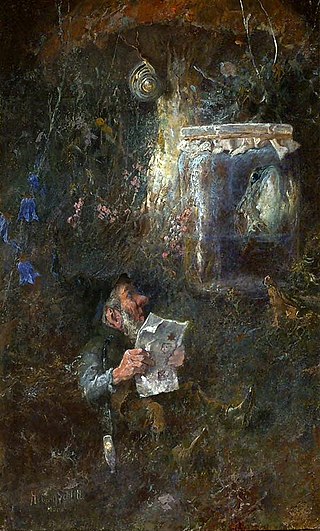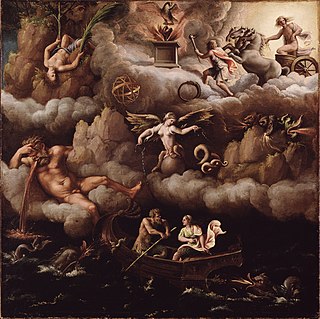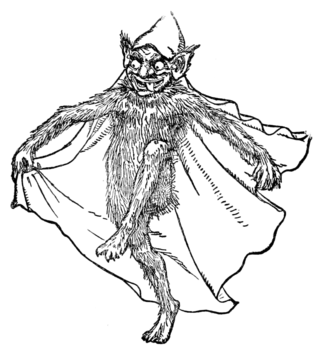![Bugbear sculpture in Thieles Garten [de], Bremerhaven (2006) Bremerhaven Thiele 2.jpg](http://upload.wikimedia.org/wikipedia/commons/thumb/d/da/Bremerhaven_Thiele_2.jpg/220px-Bremerhaven_Thiele_2.jpg)
A bugbear is a legendary creature or type of hobgoblin comparable to the boogeyman (or bugaboo or babau or cucuy), and other creatures of folklore, all of which were historically used in some cultures to frighten disobedient children. [1]
![Bugbear sculpture in Thieles Garten [de], Bremerhaven (2006) Bremerhaven Thiele 2.jpg](http://upload.wikimedia.org/wikipedia/commons/thumb/d/da/Bremerhaven_Thiele_2.jpg/220px-Bremerhaven_Thiele_2.jpg)
A bugbear is a legendary creature or type of hobgoblin comparable to the boogeyman (or bugaboo or babau or cucuy), and other creatures of folklore, all of which were historically used in some cultures to frighten disobedient children. [1]
Its name is derived from the Middle English word "bugge" (a frightening thing), or perhaps the Old Welsh word bwg (evil spirit or goblin), [2] or Old Scots bogill (goblin), and cognates most probably English "bogeyman" and "bugaboo".
In medieval England, the bugbear was depicted as a creepy bear that lurked in the woods to scare children. It was described in this manner in The Buggbears, [2] an adaptation, with additions, from Antonio Francesco Grazzini’s La Spiritata (‘The Possessed [Woman]’, 1561). [3]
In a modern context, the term bugbear may also mean pet peeve. [4]
Bugbears appear in a number of modern fantasy literature and related media, where they are usually minor antagonists. [5] They also appear as monsters, described as large, hairy goblinoids, in the canon of popular fantasy role-playing games. [6] [7]
The show My Little Pony: Friendship Is Magic introduced bugbears to the series in the 100th episode Slice of Life. Bugbears in the show are depicted as being literal to the name, being a four-armed panda with the antennae, wings, and stinger of either a wasp or bumblebee.

A gnome is a mythological creature and diminutive spirit in Renaissance magic and alchemy, introduced by Paracelsus in the 16th century and widely adopted by authors including those of modern fantasy literature. Typically small humanoids who live underground, gnome characteristics are reinterpreted to suit various storytellers and artists.
In the philologist and fantasy author J. R. R. Tolkien's Middle-earth fiction, a warg is a particularly large and evil kind of wolf that could be ridden by orcs. He derived the name and characteristics of his wargs by combining meanings and myths from Old Norse and Old English. In Norse mythology, a vargr is a wolf, especially the wolf Fenrir that destroyed the god Odin in the battle of Ragnarök, and the wolves Sköll and Hati, Fenrir's children, who perpetually chase the Sun and Moon. In Old English, a wearh is an outcast who may be strangled to death.
A boggart is a creature in English folklore, either a household spirit or a malevolent genius loci inhabiting fields, marshes, or other topographical features. Other names of this group include bug, bugbear, bugaboo or bug-a-boo, bogey, bogun, bogeyman, bogle, etc., presumably all derived from Old English pūcel, and related to the Irish púca and the pwca or bwga of Welsh mythology.

A monster is a type of fictional creature found in horror, fantasy, science fiction, folklore, mythology and religion. Monsters are very often depicted as dangerous and aggressive, with a strange or grotesque appearance that causes terror and fear, often in humans. Monsters usually resemble bizarre, deformed, otherworldly and/or mutated animals or entirely unique creatures of varying sizes, but may also take a human form, such as mutants, ghosts, spirits, zombies, or cannibals, among other things. They may or may not have supernatural powers, but are usually capable of killing or causing some form of destruction, threatening the social or moral order of the human world in the process.

A kobold is a mythical sprite. Having spread into Europe with various spellings including "goblin" and "hobgoblin", and later taking root and stemming from Germanic mythology, the concept survived into modern times in German folklore.

In fantasy fiction, a lich is a type of undead creature.

The bogeyman is a mythical creature used by adults to frighten children into good behaviour. Bogeymen have no specific appearance and conceptions vary drastically by household and culture, but they are most commonly depicted as masculine or androgynous monsters that punish children for misbehaviour. The bogeyman and conceptually similar monsters can be found in many cultures around the world. Bogeymen may target a specific act or general misbehaviour, depending on the purpose of invoking the figure, often on the basis of a warning from an authority figure to a child. The term is sometimes used as a non-specific personification of, or metonym for, terror, and sometimes the Devil.

A cacodemon is an evil spirit or a demon. The opposite of a cacodemon is an agathodaemon or eudaemon, a good spirit or angel. The word cacodemon comes through Latin from the Ancient Greek κακοδαίμων kakodaimōn, meaning an "evil spirit", whereas daimon would be a neutral spirit in Greek. It is believed to be capable of shapeshifting. A cacodemon is also said to be a malevolent person.
An owlbear is a fictional creature originally created for the Dungeons & Dragons fantasy role-playing game. An owlbear is depicted as a cross between a bear and an owl, which "hugs" like a bear and attacks with its beak. Inspired by a plastic toy made in Hong Kong, Gary Gygax created the owlbear and introduced the creature to the game in the 1975 Greyhawk supplement; the creature has since appeared in every subsequent edition of the game. Owlbears, or similar beasts, also appear in several other fantasy role-playing games, video games and other media.
A bodach is a trickster or bogeyman figure in Gaelic folklore and mythology. The bodach "old man" is paired with the cailleach "hag, old woman" in Irish legend.
In English folklore, grindylow or grundylow is a creature in the counties of Yorkshire and Lancashire. The name is thought to be connected to Grendel, a name or term used in Beowulf and in many Old English charters where it is seen in connection with meres, bogs and lakes.

Kobolds are a fictional race of humanoid creatures, featured in the Dungeons & Dragons roleplaying game and other fantasy media. They are generally depicted as small reptilian humanoids with long tails, distantly related to dragons.

In the Dungeons & Dragons fantasy role-playing game, goblins are a common and fairly weak race of evil humanoid monsters. Goblins are non-human monsters that low-level player characters often face in combat.
In Scotland, a wirry-cow is a bugbear, goblin, ghost, ghoul or other frightful object. Sometimes the term is used for the Devil or a scarecrow.
Draggled sae 'mang muck and stanes, They looked like wirry-cows
The kobalos was a sprite from Greek mythology, a mischievous creature fond of tricking and frightening mortals. The kobaloi were companions of Dionysus and could shapeshift as Dionysus in the guise of Choroimanes-Aiolomorphos. According to one myth, they robbed Herakles while he slept. He captured them in revenge but took pity on them when he found them amusing. In one version of the myth, Herakles gave them to the Lydian queen Omphale as a gift. The kobaloi were thought to live in Euboea or near Thermopylae. Parents used tales of the kobaloi to frighten children into behaving.

A hag is a wizened old woman, or a kind of fairy or goddess having the appearance of such a woman, often found in folklore and children's tales such as "Hansel and Gretel". Hags are often seen as malevolent, but may also be one of the chosen forms of shapeshifting deities, such as The Morrígan or Badb, who are seen as neither wholly benevolent nor malevolent.

A goblin is a small, grotesque, monstrous creature that appears in the folklore of multiple European cultures. First attested in stories from the Middle Ages, they are ascribed conflicting abilities, temperaments, and appearances depending on the story and country of origin, ranging from mischievous household spirits to malicious, bestial thieves. They often have magical abilities similar to a fairy or demon, such as the ability to shapeshift.
An orc, in J. R. R. Tolkien's Middle-earth fantasy fiction, is a race of humanoid monsters, which he also calls "goblin".

Character race is a descriptor used to describe the various sapient species and beings that make up the setting in modern fantasy and science fiction. In many tabletop role-playing games and video games, players may choose to be one of these creatures when creating their player character (PC) or encounter them as a non-player character (NPC). "People" is to be taken in the broader sense, and may encompass ethnic groups, species, nationality or social groups.

The gargoyle is a fantasy and horror monster inspired by the gargoyle architectural element. While they were believed in mythology to frighten away evil spirits, the idea of such statues physically coming to life is a more recent notion. Like golems, they are usually made of magically animated or transformed stone, but have animal or chimera traits and are often guardians of a place such as a cathedral or castle. They can also be depicted as vessels for demonic possession or as a living species resembling statues.